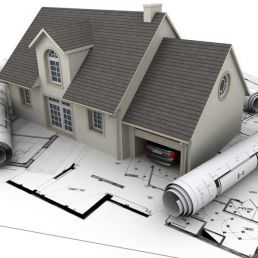So why use Development Finance?
Main Advantages are:
- By financing the project, this gives you options and flexibility to take on other, larger projects that you may not otherwise be in a financial position to consider, increasing your potential profits and freedom to grow.
- Utilising development finance, you may be able to undertake multiple projects simultaneously, or avoid having to wait until an existing project is sold, or is fully sold, before starting your next development. Using finance can help avoid missing out on your next project or on other potential opportunities.
- Your return on investment rate (ROI) will be greater if you are putting in less capital. Although you will have the cost of the financing to pay from your profits, the actual rate of return on the amount that you have personally invested will be higher.
- Avoids tying up a substantial proportion of your cash until the project is sold.
How much can I borrow?
You can normally borrow 70% of the land/site cost and 100% of the build cost.
Increased borrowing including 100% development finance is possible.
When looking at how much you can borrow you will need to factor in:
- Land costs
- Development costs
- Lender fees – set up fees, exit fees
- Professional fees and costs – solicitors, surveyors, etc
- Contingency costs
Types of development project
Refurbishment, restoration and property conversions
Different lenders will have their own definition of light and heavy refurbishment, but generally:
- Light refurbishment – mainly aesthetic rather than structural changes to the property. For example: new kitchen, bathroom, windows and central heating.
- Heavy refurbishment or renovation – involving things like new plumbing, electrics, moving internal walls, partial demolition and rebuild, extensions, attic conversions and converting a property into apartments/flats.
Ground up development projects
Development finance can be used to finance both the land purchase, and also the build costs.
The highest loan to value development finance plans will fund up to 70% of the land cost and 100% of the build costs, provided the loan amount does not exceed 70% of the gross development value.
However, facilities that offer as much as 70% of the land cost and 100% of the build cost, are specialist. Therefore, their interest rates, set up and exit fees, usually all carry a premium, along with also having stricter underwriting criteria.
To obtain the best deals it is best to restrict development finance facilities to 60% of the land cost and 100% of the build cost.
An example of ground up development finance
A plot of land with planning permission to build four, three bed detached houses. The land can be purchased for £250,000 and the cost to build all four houses will be £400,000.
The estimated value of each house is £250,000 meaning a Gross Development Value (GDV) of (4 x £250,000) £1,000,000.
Development finance can be used to raise up to 70% of the land cost = £175,000 and all of the build cost.
Therefore, a facility would be set up for £575,000 (net). The initial release would be for £175,000 and used to help fund the purchase of the land.
The remaining £400,000 will be released in stages as the build progresses.
With most facilities interest is only charged on funds that have been drawn.

The process involved
The stages of development finance
- Enquiry stage & Engagement to act on your behalf
- Agreement in Principle – Indicative Terms
- Development Site Visit
- Valuation
- Formal Loan Offer
- Solicitors
- Completion – First Drawdown
- Drawdowns to fund build costs
- Redemption (Exit plan) – Usually when the development is sold or refinanced
How will the funds be paid out?
Payments will usually be made in stages as the project proceeds.
- Initial payment to secure the site – typically up to 70% of the site’s current value
- Staged payments throughout the life of the project, in line with the agreed plan of works. Accuracy is essential when it comes to working out your build schedule and costs in order to ensure adequate cash flow throughout the project.
Do I have to make interest payments during the term of the loan?
Most development finance facilities are set up to allow monthly interest charges to be added to the loan facility. The interest is then repaid when the loan is redeemed.
Having the interest added to the facility takes pressure off the developer so that they can concentrate on the development.
Obviously if units are sold during the course of the development, some or all of the proceeds will be used to reduce the amount outstanding on the development finance facility.
Why do the lenders allow monthly interest charges to be added to the loan?
When undertaking a development project, income is not generated each month, only when the completed development or units within the development are sold. Therefore, there is no regular monthly income, so easier to allow payments to be added each month rather than missed, leading to potential loan default problems.

How to repay your development finance
All lenders will want to see a clear exit plan before they will agree your loan. The most common exit routes are:
- Sale of the finished property / site
- Refinancing using a developer exit product – this will usually be at a lower rate, enabling you to clear the original development loan and providing you with finance until the site is sold.
- Long term refinancing – if this is your planed exit route it can be advantageous to have this lined up when you apply for your development finance as lenders will then have the certainty of a clear exit route. Long term refinancing would be used when the developer plan to keep the finished development for themselves to use or rent out.
How Development Finance Facilities are usually Repaid
For every month a development finance facility is outstanding, interest charges are being incurred.
Developers will therefore want to limit any delays and ensure any development finance is repaid as quickly as possible.
Development projects are usually repaid through sale or refinance:
Build to sell – when the developer sells the completed development, either as a whole, or as individual/multiple units.
Build to rent – which is when the developer refinances the completed development, upon its completion, onto a long-term facility, enabling the property developer to rent the new property out. We can also help at this stage to consider a traditional buy-to-let mortgage facility for you.
Or a combination of build to sell and build the rent – this is when a developer sells off some of the completed units and also keeps a number of the units for themselves, in order to rent out as investment properties.
Finance solutions for your business
Contact our super friendly team today
We help to finance land acquisition, multiple plot development, HMO’s, Buy-to-let opportunities and develop to sell projects. By either having existing or previous experience in this sector, or at the very least a clear financial and final exit plan in place for your project, this will greatly increase your chances of obtaining funding. Typically you can borrow up to a max 70% of the land/site cost and 100% of the build cost. Increased borrowing including 100% development finance is possible, provided the loan amount does not exceed 70% of the gross development value (GDV). However, as that option is specialist, interest rates, set up and exit fees, usually carry a premium, along with also having stricter underwriting criteria.
MoreServices
Marine and Aviation Finance
Marine mortgages, new and used light, executive, commercial aircraft and helicopters.
Commercial Mortgages
We can assist with financing new premises for your trading business
Bridging Loans
Providing a speedy, flexible approach to bridging loans
Stock & Trade Finance
Financing your growth through innovative lending solutions


